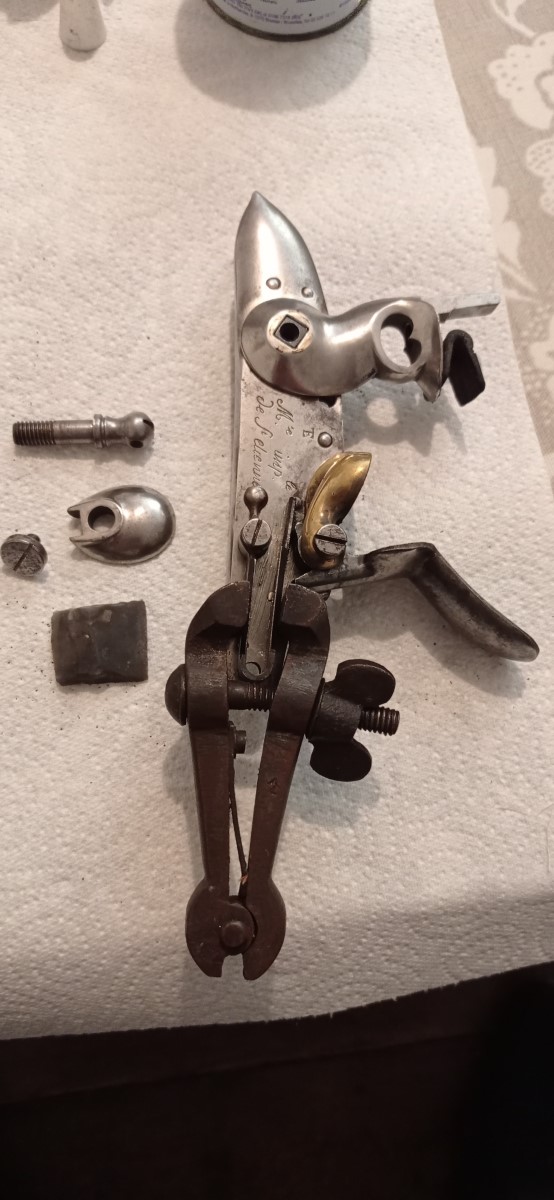Cleaning A Napoleonic Charleville Musket - Part 3 - Cleaning The Lock
This is the final part of a short series showing you how to clean a flintlock musket - in this case, a Pedersoli replica of a French Napoleonic Charleville An IX model.
The first two posts were Cleaning A Napoleonic Charleville Musket - Part 1 - Terminology and Cleaning A Napoleonic Charleville Musket - Part 2 - Disassembly and Barrel Cleaning
Now it's time to clean the lock mechanism.
The basic principle is simple; remove parts and clean each in turn, but don't take apart anything which doesn't need to be dismantled.
In practice, this means that the inside of the lock shouldn't need to be fully dismantled too often, which is a good thing because fiddling with the main spring is always a difficult and risky job.
I do actual cleaning with brasso wadding for light powder deposits and Autosol for heavier ones. Autosol is midly abrasive, so I don't like to use it unless absolutely neccessary. After each is used, I use clean rag or kitchen roll to thoroughly wipe off the surfaces.

Step one is to undo the top jaw screw, remove the flint (which is likely to still be sharp !) and upper jaw. Note that I use a leather patch to hold the flint, but it's also possible to use an oval of lead sheet.
This photo also shows the screw thgat holds the hammer on removed. It's mostly just for cleaning. On my musket (although not all of them) the hammer is such a tight fit onto the tumbler that it's very hard to remove. That means it's best left alone, as a tight fit is exactly what it needs !
You can also see that I've got my spring clamp locked around the frizzen screw. The frizzen, frizzen spring and pan are the areas that always have the heaviest deposits and need the most cleaning.

This shot shows the inside of the lock. The lock on this musket seals quite well against the stock and barrel, so the inside just needs to be wiped down and re-greased. About every second or third clean I'll use WD40 to "wash" it thoroughly before re-greasing.
The grease I like to use is Pronatur, which is nice and sticky and tends to stay where I put it. On the inside of the lock, it needs to be used on the plate behind the main spring to lubricate the area of travel of the spring. Additionally, the tumbler, beneath the bridle and all around the sear spring should get plenty of grease. The grease provides lubrication, but also soaks up the corrosive combustion vapours and protects the underlying metal from them.

This last photo shows the front of the lock fully stripped down with all the component parts laid out. I've used the spring clamp to put some tension on the main spring (but not as much as is needed to remove it) to make it easier to remove and replace the pan.
Once all the parts are clean, it's just a case of reassembling them in reverse order, starting with the pan.
The front and underside of the frizzen needs to be kept totally oil and grease free, but apart from that, the frizzen screw needs greasing, as does the back of the frizzen spring and the top area where the heel of the frizzen slides along the spring. Additionally, I usually put a small dab of grease on the thread of the upper jaw screw, simply because it's so exposed to the blowback of hot, corrosive gases with every shot.
With the lock cleaned and re-greased, the barrel of the musket can be put on and the lock screwed to the outside. The lock should be stored with the frizzen open and the hammer fully forward. That way the springs are all under the least tension, which extends their life considerably.
So there we are, the musket is nicely clean ready for the next event, when the whole process starts all over again....
Posted using The BBH Project
It’s easy to make things worse if you mess with the spring or internal bits unnecessarily. Brasso and Autosol combo is pretty solid for different levels of grime.
Thank you ! Autosol is definitely one of my favourite cleaners 😀 Historically, muskets were cleaned with a paste made of olive oil and brick dust, but that's a pretty aggressive solution.
wow I barely knew this 🤔😂